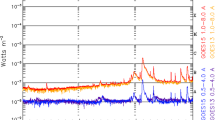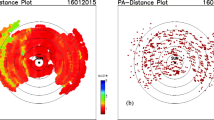Abstract
This note introduces the newly developed working modes, i.e. one-dimensional meter-wave radio heliograph (MRH) and interplanetary scintillation (IPS) telescope, of meter-wave aperture synthesis radio telescope (MSRT) at Beijing Astronomical Observatory (BAO). The note describes briefly the scientific objectives, configurations of the hardware and software, and functions of the system. It presents the examples of observations on solar meter-wave bursts and IPS with the two new working modes. The results indicated that new modes not only can provide the information on the evolution of solar activities with space and time, but also can trace and monitor the propagation and spatial distribution of interplanetary plasma shock resulting from solar activities and the instability of the ionosphere, etc. Both modes are new facilities that could fill the gaps in scientific frontiers.
Similar content being viewed by others
References
Fu, Q. J., Qin, Z. H., Ji, H. R. et al., A broadband spectrometer for decimeter and microwave radio bursts, Solar Phy., 1995, 160: 97.
Kondo, T., Isobe, T., Igi, S. et al., The Hiraiso radio spectrograph (HiRAS) for monitoring solar radio bursts, J. Commun. Res. Lab, 1995, 42: 111.
Prestage, N. P., Luckhurst, R. G., Paterson, B. R. et al., A new radiospectrograph at culgoora, Solar Physics, 1994, 150: 393.
Zhang, X. Z., Piao, T. Y., Pang, L., The new role of MSRT-A radio heliograph, Publ. of Purple Mountain Observatory, 1999, 18: 179.
Ramesh, R., Subramanian, K. R., Sundararajan, M. S. et al., The Gauribidanur radioheliograph, Solar Physics, 1998, 181: 439.
Wei, F. S., Space synoptics, Progress in Geophysics, 1999, 14: 1.
Grapper, G. R., Hewish, A., Purvis, A. et al., Observing interplanetary disturbances from the ground, Nature, 1982, 296: 633.
Asai, K., Ishida, Y., Kojima, M. et al., Multi-station system for solar wind observations using the interplanetary scintillation method, J. Geomag. Geoeletr., 1995, 47: 1107.
Manoharan, P. K., Ananthakrishnan, S., Dryer, M. et al., Solar wind velocity and normalized scintillation index from singlestation IPS observations, Solar Physics, 1995, 156: 377.
Wang, S. G., The design, construction and result of the test observation of the Miyun aperture synthesis radio telescope, Publ. of BAO, 1985, 7: 1.
Li, C. S., Fu, Q. J., Origin of solar radio burst: Flares and/or CME, Publ. of Purple Mountain Observatory, 1999, 18: 161.
Wu, J., Zhang, X., Zheng, Y., IPS observations at Miyun Station, BAO, Ap&SS, 2001(in press).
Author information
Authors and Affiliations
Corresponding author
About this article
Cite this article
Zhang, X., Wu, J., Chen, H. et al. New developments of MSRT’s working modes: One-dimensional radio heliograph and IPS telescope. Chin.Sci.Bull. 46, 1598–1602 (2001). https://doi.org/10.1007/BF02900614
Received:
Issue Date:
DOI: https://doi.org/10.1007/BF02900614




